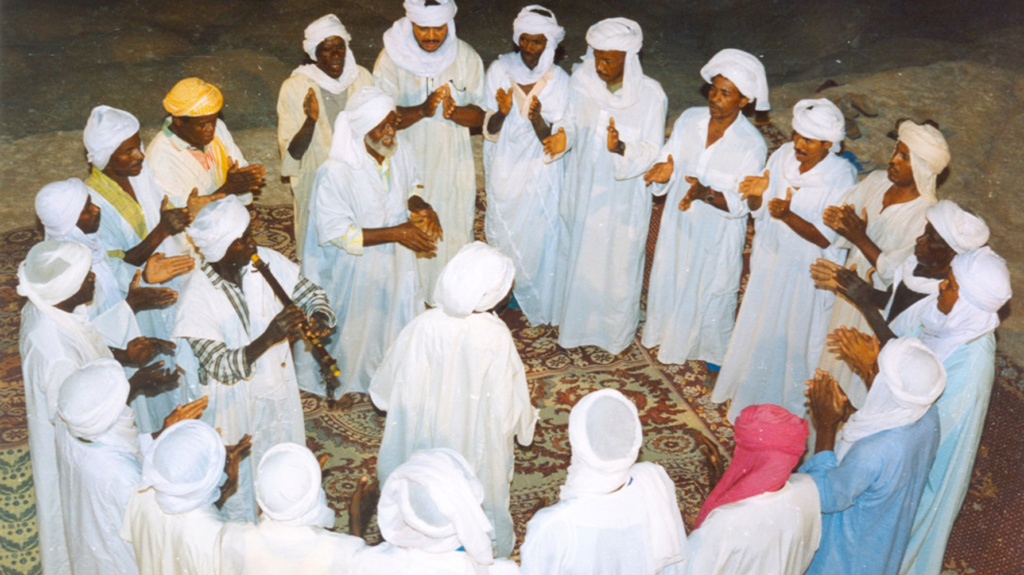Ohlil Guarara.. Algerian folklore resists extinction between the "night" and the "crescent moon"

UNESCO's recognition of the Algerian art of Ahleil Gurrara as part of the intangible world heritage in 2008 constituted a pivotal event in the history of this ancient art, which is threatened with extinction.
Historical sources say that the Amazighs of Algeria knew “Ahlil” before Islam entered the country, and they called it “Aznoun.” They also indicate that during that period he was distinguished by his boldness in spinning and in dealing with some social issues, before he became, after entering Islam, a mystical art praising the Messenger and his companions. .

The art of Ahlil is widespread in the Qourara region, located in the state of Adrar, southwest of Algeria, the region in which many Zanatian Amazigh tribes settled and to which credit is due for the maintenance of this art with the passage of ages.
?Why was it called Ahleel
"Some believe that this name is derived from + the people of the night + given that this singing is performed at night, while others linked it to the crescent moon, and others go to the fact that the word came from the applause to God and from the phrase there is no god but God," explains the Algerian researcher Hajar Hamdawi, in An article entitled "The Heritage Cultural Diversity in Algeria, Confirmation of Identity and Preservation of Memory from Loss."
In his definition of the UNESCO list of intangible world heritage, Ahleel is performed in religious ceremonies as well as in some social events such as weddings, and this art includes "poetry, music and dance", and about a hundred people participate in the performance "standing shoulder to shoulder in a circle surrounding the singer and moving slowly around him while applauding." .

Regarding these poems, Professor at the University of Algiers, Nabil Al-Huwaili, explains in an article entitled “The Rhymes of Al-Qurarah, The Aesthetic of Rhetoric and the Question of Identity,” the characteristics of Ahleel’s art, by saying that it is “like a group of combined arts, as it is literature, music, a dance party, and a joyful celebration, (...) Participants wear special clothes for the demonstration. The men were wearing a dress called "chamir", which is a long suit, a woolen haik of 8 meters in length and a green and red handkerchief, while the participating women wore a haik called "tafilalith" and a long shirt called "agrumbuz".
Al-Huwaili adds that lights and lights are often dispensed with on occasions that know the presence of women so that their faces do not appear to the audience of Ahleel, stating that the concerts of this art start at eleven in the night with an opening that is a prayer for the Prophet Muhammad, and then comes Sufi chants that continue until dawn.

Among Ahleel’s poems, what was reported by the Amazigh writer and activist Mouloud Mamari (1917-1989), because of which the events of the “Amazigh Spring” broke out in Algeria in 1980, in his reference research on Ahleel entitled “Ahleel Qurara”, which is as follows: Peace and blessings be upon you, my master Muhammad,
Our Prophet
In the name of God, I say it many times,
there is no god but God,
my Lord , Glory be to Him , He is the Living Who
does not die.
Maamari divided the rituals of performing the art of Ahleel into three phases. The first is called “Al-Misrab”, and it begins with sunset until midnight. Midnight to dawn, and her poems sing of heroism and glories, then a third stage called "Tetra", and it starts from dawn to sunrise and is dominated by optimism and optimism, according to an article by the Algerian journalist Abd al-Razzaq Boukba.
threatened with extinction
Despite its classification as an intangible world heritage in 2008, UNESCO warned of the possibility of the extinction of this art, and placed it among the threatened arts due to the lack of seasons and events in which it is performed, the migration of young people from the oases of Qawara to the cities, and the preference of some to listen to its recordings instead of participating in live performances of it.
Source : websites

